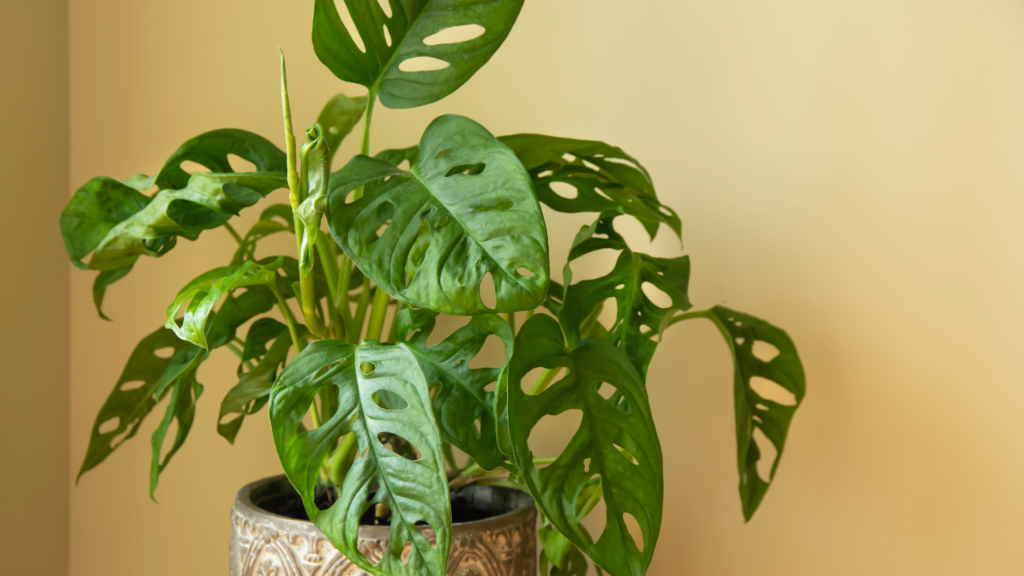Are you ready to expand your indoor garden? Propagating Swiss Cheese Plant is a rewarding and simple process that anyone can do. Whether you have a Monstera adansonii or Monstera deliciosa, there are various methods you can use to propagate these beautiful plants and create new additions to your collection.
Table of Contents
ToggleKey Takeaways on How to Propagate Swiss Cheese Plant
- Propagating Swiss Cheese plants is a simple and rewarding process that anyone can do.
- One method of propagation is through stem cuttings, where a stem is cut just below a node and rooted in water or soil.
- Water propagation involves placing the cutting in a jar of clean water until roots form, while soil propagation requires burying the cutting in well-draining soil.
- Swiss Cheese Plants can also be propagated through division, by separating mature plants into smaller ones, or through air layering, where root growth is encouraged on a portion of the plant while it remains attached to the parent.
- Choosing the right potting mixture and providing ideal growing conditions, such as bright indirect light and a warm location, are crucial for the success of newly propagated plants.
Understanding Swiss Cheese Plant Propagation
Before diving into the propagation process, it’s important to understand the different methods available and the key tips for successfully propagating the Swiss Cheese Plant. This popular houseplant, also known as Monstera deliciosa, can be easily propagated through various techniques.
One common method is stem-cutting propagation. Simply cut a stem just below a node and remove any leaves from the bottom half. To enhance rooting, dip the cut end in the rooting hormone. You can then choose to either root the cutting in water or directly in soil.
If you opt for water propagation, place the cutting in a jar with clean, room-temperature water. Cover the jar with plastic wrap to create a mini greenhouse effect. Remember to replace the water every few days to prevent stagnation. After a few weeks, when substantial roots have formed, transfer the cutting to a small container with well-draining soil.
Alternatively, you can root the cutting directly in the soil. Choose a pot with well-draining soil and bury at least two inches of the stem in the soil. Keep the soil moist but not wet, and provide bright indirect light. Within four to six weeks, roots should start to form, and your new Swiss Cheese Plant will be on its way to becoming a healthy and thriving plant.
| Propagation Method | Advantages |
|---|---|
| Stem Cutting | Easy and straightforward |
| Water Propagation | Allows you to observe root growth |
| Soil Propagation | Provides a natural environment for root development |
| Division Propagation | Allows for multiple new plants |
| Air Layering Propagation | Provides higher success rates for certain plants |
Tips for Successful Swiss Cheese Plant Propagation
- Choose healthy and mature plants as the parent plants for propagation.
- Use sterilized tools when taking stem cuttings to prevent the spread of diseases.
- Provide consistent moisture to the rooting medium without overwatering.
- Place newly propagated plants in a warm location with bright indirect light to promote healthy growth.
- Use a potting mixture that allows for good airflow, such as a combination of potting soil, orchid bark, and perlite.
By understanding the different propagation methods and following these tips, you can easily propagate the Swiss Cheese Plant and enjoy the rewards of expanding your indoor garden. Whether you choose stem cutting, water propagation, soil propagation, division, or air layering, each method offers its own unique benefits and can result in successful plant propagation.

Stem Cutting Propagation
One of the most popular methods for propagating Swiss Cheese Plant is through stem cuttings, and here’s how you can do it successfully.
To start, cut a stem just below a node, which is where the leaf attaches to the stem. Make sure the cutting is about 4-6 inches long. Remove any leaves from the bottom half of the cutting, as these can rot when placed in water or soil.
Next, dip the cut end of the stem in the rooting hormone. This will help stimulate root growth and increase the chances of successful propagation. Once the cutting has been treated with rooting hormone, it can be rooted using either the water or soil method.
Water Method
For the water method, place the cutting in a jar with clean, room-temperature water, ensuring that the cut end is submerged. Cover the jar with plastic wrap or a plastic bag to create a humid environment. Keep the jar in a warm location with bright indirect light. Replace the water every few days to prevent it from becoming stagnant. After a few weeks, roots should start to form. Once the roots are substantial, it’s time to plant the cutting in soil.
Soil Method
When using the soil method, fill a small container with well-draining soil. Bury at least two inches of the stem in the soil, making sure the cut end is covered. Lightly press the soil around the stem to secure it. Place the container in a warm location with bright indirect light. Keep the soil moist but not wet, as overly wet soil can cause the cutting to rot. After about four to six weeks, roots should form, and the newly propagated plant can be treated like a mature Swiss Cheese Plant.
Remember, successful propagation requires patience and care. It’s important to remember that not every cutting will root successfully, but with practice and attention to detail, you can increase your chances of success. Enjoy the process of propagating Swiss Cheese Plants and watch as your new plants grow and thrive!
Water Propagation
Water propagation is a popular approach for propagating Swiss Cheese Plants, and it can lead to successful growth when done correctly. To propagate using this method, start by taking a stem cutting from a healthy, mature plant. Cut just below a node and remove any leaves from the bottom half of the cutting. This will help prevent the leaves from rotting in the water.
Next, dip the cut end of the stem in the rooting hormone. This will stimulate root development and increase the chances of successful propagation. Fill a clean jar with room-temperature water and place the cutting in the jar. Make sure the nodes are submerged in the water while the leaves remain above the waterline. Cover the jar with plastic wrap to create a humid environment. This will help retain moisture and encourage root growth.
It’s important to change the water every few days to prevent the growth of bacteria or mold. After a few weeks, you should start to see roots forming from the nodes. Once the roots are substantial, gently remove the cutting from the water and plant it in a small container with well-draining soil. Keep the soil moist but not wet and place the container in a location with bright indirect light. With proper care, your propagated Swiss Cheese Plant should continue to grow and thrive.
| Pros of Water Propagation | Cons of Water Propagation |
|---|---|
| – Easy method for beginners | – Requires regular water changes |
| – Allows for easy monitoring of root growth | – Risk of overwatering |
| – Can be visually appealing with roots in water | – Takes longer for roots to develop compared to other methods |
Water propagation is a great way to propagate Swiss Cheese Plant and witness the growth of roots in a beautiful, clear jar. However, it’s important to be patient and provide the necessary care to ensure successful growth. With time and proper care, you’ll be rewarded with a healthy and thriving Swiss Cheese Plant.
Soil Propagation
If you prefer a more direct approach, propagating Swiss Cheese Plant in soil is a great option, and here’s how you can do it effectively. Start by selecting a small container with good drainage. Fill it with a well-draining potting mixture, such as a blend of potting soil, orchid bark, and perlite.
Take a stem cutting from the parent plant, making sure it has at least two leaves and a few nodes. Bury the bottom two inches of the stem in the soil, ensuring that at least one node is below the surface. Gently press the soil around the cutting to secure it in place.
Maintain a moist but not wet soil environment by watering the cutting regularly. Avoid overwatering, as excessive moisture can lead to root rot. Place the container in a warm location with bright indirect light. A temperature of around 70°F (21°C) is ideal for successful propagation.
Within four to six weeks, you should start seeing roots forming from the buried node. Once the roots are substantial enough, you can consider transplanting the propagated plant into a larger pot. Remember to provide proper care and continue to monitor the soil moisture levels to ensure the plant’s healthy growth.
| Materials Needed: | Instructions: |
|---|---|
| – Small container with good drainage | – Fill the container with well-draining potting mixture |
| – Stem cutting with at least two leaves and a few nodes | – Bury the bottom two inches of the stem in the soil |
| – Water | – Regularly water the cutting, keeping the soil moist but not wet |
| – Warm location with bright indirect light | – Place the container in a warm spot with indirect light |

Division Propagation
Division propagation is an excellent method for expanding your Swiss Cheese Plant collection, and it’s a straightforward process that yields great results. By separating mature plants into multiple smaller ones, you can create new plants that will thrive in no time. Here’s how to go about it:
- Start by selecting a healthy and well-established Swiss Cheese Plant. Look for a plant with multiple stems or a clump of stems emerging from the soil.
- Gently remove the plant from its pot, being careful not to damage the roots.
- Examine the root ball and identify natural divisions or areas where stems can be separated.
- Using a clean and sharp knife or pruning shears, carefully divide the plant into sections, making sure each section has its own set of roots and stems.
- Trim any damaged or tangled roots, ensuring that each section has a healthy root system.
- Plant each divided section in a separate container filled with a well-draining potting mixture.
- Water the newly potted divisions thoroughly, ensuring that the soil is evenly moist but not waterlogged.
- Place the divisions in an area with bright indirect light and maintain a warm and humid environment.
Within a few weeks, you should start to see new growth emerging from each division. It’s important to continue providing the right care, including regular watering and fertilizer application, to encourage healthy and vigorous growth. Once the divisions have established themselves and developed a strong root system, you can treat them as individual Swiss Cheese Plants and enjoy their beautiful foliage.
Tips for Success
Here are a few tips to ensure successful division propagation:
- Choose a mature plant with multiple stems for a better success rate.
- Make clean and precise cuts when dividing the plant to minimize any potential damage.
- Use a well-draining potting mixture to prevent waterlogging and root rot.
- Monitor the moisture level of the soil and adjust watering accordingly.
- Provide bright indirect light to promote healthy growth.
- Keep the newly divided plants in a warm and humid environment to encourage root development.
With a little patience and care, you can easily propagate your Swiss Cheese Plant collection through division and enjoy the satisfaction of nurturing new plants.
| Method | Advantages | Disadvantages |
|---|---|---|
| Division Propagation | Guaranteed success with proper care | Requires mature plant for division |
| Stem Cutting Propagation | Quick and easy method | Varied success rate |
| Water Propagation | Allows for easy root development observation | Roots may be sensitive to transplanting |

Air Layering Propagation
Air layering is a fascinating method to propagate Swiss Cheese Plants, and it allows you to create new plants without removing them from the parent plant. This technique is especially useful if you have a well-established plant with long branches that can easily be manipulated. By encouraging root growth on a portion of the stem while it remains attached to the parent plant, you can create a new plant with a strong root system.
To begin air layering, select a healthy and mature branch that you want to propagate. Make a small incision on the underside of the stem, about halfway between two nodes. Insert a toothpick or a small piece of wood to keep the incision open. Dust the area with rooting hormone to encourage root development.
Next, take a handful of moist sphagnum moss and wrap it around the incision, making sure to cover the exposed area completely. Secure the moss in place by wrapping plastic wrap around it. This will create a moist and enclosed environment for root growth.
After a few weeks, you should start seeing roots forming within the moss. Once the roots are well-developed and strong, you can carefully cut the new plant from the parent plant, making sure to keep the roots intact. Plant the new plant in a well-draining potting mixture and provide it with the appropriate care and growing conditions.
Choosing the Right Potting Mixture
The choice of potting mixture plays a crucial role in the successful propagation of the Swiss Cheese Plant, and here’s what you need to know when selecting the right one.
When it comes to potting mixtures for propagating Swiss Cheese Plant, it’s essential to create an environment that promotes root development and provides adequate drainage. A well-draining mixture will prevent waterlogged conditions that can lead to root rot and other issues. Here’s a breakdown of the components you should consider:
- Potting Soil: Look for a well-balanced potting soil that is rich in organic matter. This will provide nutrients and a stable structure for the roots to anchor into.
- Orchid Bark: Adding orchid bark to the potting mixture helps to improve drainage and aeration. It also mimics the natural habitat of Swiss Cheese Plants, which grow as epiphytes in the wild.
- Perlite: Perlite is a lightweight volcanic rock that helps to increase drainage while retaining some moisture. It prevents the potting mixture from becoming overly compacted and allows air to reach the roots.
Creating the Perfect Ratio
An ideal potting mixture for propagating Swiss Cheese Plant consists of equal parts potting soil, orchid bark, and perlite. This ensures a well-balanced blend that provides both support and adequate drainage for the developing roots. Mix the components thoroughly before potting your cuttings.
By choosing the right potting mixture and providing the ideal conditions, you can greatly increase your chances of success when propagating the Swiss Cheese Plant. Remember to keep the newly propagated plants in a warm location with bright indirect light, and monitor their growth closely as they establish themselves in their new environment.
| Component | Function |
|---|---|
| Potting Soil | Provides nutrients and stability |
| Orchid Bark | Improves drainage and aeration |
| Perlite | Increases drainage and prevents compaction |

Ideal Growing Conditions for Newly Propagated Swiss Cheese Plants
Newly propagated Swiss Cheese Plants require specific growing conditions to establish themselves successfully, and here’s what you need to consider to support their growth.
- Temperature: Keep the temperature between 65-85°F (18-29°C) to provide a warm environment that promotes root development and overall plant growth.
- Light: Place your propagated plants in an area with bright indirect light. Avoid direct sunlight, as it can scorch the leaves. A north or east-facing window is usually ideal.
- Humidity: Maintain a moderately humid environment. You can achieve this by placing a tray filled with water near the plants or using a humidifier. Misting the leaves occasionally can also help increase humidity.
- Watering: Water your newly propagated Swiss Cheese Plants when the top inch of soil feels dry. Avoid overwatering, as this can lead to root rot. Ensure that the pot has good drainage to prevent waterlogging.
- Fertilization: After about six weeks of propagation, you can start fertilizing your plants. Use a balanced liquid fertilizer diluted to half-strength. Apply it every two to four weeks during the growing season.
In addition to these specific conditions, it’s essential to choose the right potting mixture. Swiss Cheese Plants thrive in a well-draining mixture that allows proper airflow around the roots. A suitable mix can be created by combining potting soil, orchid bark, and perlite in equal parts. This composition ensures good drainage and aeration, preventing root rot.
Remember to keep your newly propagated plants in a warm location with bright indirect light, and monitor their growth and health regularly. With proper care and attention, your Swiss Cheese Plants will thrive and bring beauty to your indoor space.
| Temperature | Light | Humidity | Watering | Fertilization |
|---|---|---|---|---|
| 65-85°F (18-29°C) | Bright indirect light | Moderate humidity | When top inch of soil is dry | Diluted balanced liquid fertilizer every 2-4 weeks |

Maintenance and Care Tips for Propagated Swiss Cheese Plants
Proper maintenance and care are essential for the long-term health and prosperity of your propagated Swiss Cheese Plants, and here are some tips to keep in mind.
1. Watering: It’s important to provide your propagated Swiss Cheese Plants with consistent, adequate hydration. Water the plants when the top inch of the soil feels dry to the touch. Avoid overwatering, as excessive moisture can lead to root rot. Maintain a balance by allowing the soil to dry out slightly between waterings.
2. Light: Swiss Cheese Plants thrive in bright, indirect light. Place your propagated plants near a window with filtered sunlight or provide them with artificial grow lights. Avoid placing them in direct sunlight, as it can scorch the leaves. Rotate the plants occasionally to ensure even growth and prevent them from leaning toward the light source.
3. Fertilizing: To promote healthy growth, feed your propagated Swiss Cheese Plants with a balanced, water-soluble fertilizer. Apply the fertilizer according to the package instructions, usually every 2-4 weeks during the growing season. Avoid overfertilizing, as it can lead to burned roots and foliage. Always dilute the fertilizer to the recommended strength.
4. Pruning: Regular pruning helps maintain the shape and size of your propagated Swiss Cheese Plants. Trim back any yellowing or damaged leaves to encourage new growth. If the plant becomes leggy or unruly, consider pinching or cutting back the stems to promote bushier growth. Use clean, sharp pruning shears to prevent the spread of diseases.
| Tip | Table |
|---|---|
| Use a humidifier or place a tray of water next to your propagated Swiss Cheese Plants to increase humidity levels, as they prefer moderately high humidity. | For best results, maintain a temperature range of 65-85°F (18-29°C) for your propagated plants. Avoid exposing them to temperature extremes or drafts. |
By following these maintenance and care tips, your propagated Swiss Cheese Plants will flourish and bring beauty to your indoor space. Remember to provide them with the right balance of water, light, and nutrients, and they will reward you with lush foliage and a vibrant presence.

Troubleshooting Common Issues in Swiss Cheese Plant Propagation
Even with the best techniques, issues can occur during the propagation of the Swiss Cheese Plant, but with the right troubleshooting measures, you can overcome them and achieve successful propagation. Here are some common problems that you may encounter and how to address them:
- Poor root development: If you notice that the roots of your propagated Swiss Cheese Plant are not developing as expected, it could be due to inadequate moisture or insufficient nutrients. Check the moisture level of the soil and make sure it is consistently moist but not waterlogged. Consider using a balanced liquid fertilizer to provide essential nutrients to the plant.
- Yellowing leaves: Yellow leaves can indicate various issues, including overwatering, underwatering, or nutrient deficiencies. Check the moisture level of the soil and adjust watering accordingly. If the soil is consistently wet, allow it to dry out before watering again. Also, ensure that your plant is receiving adequate light and consider supplementing with a balanced fertilizer to address any nutrient deficiencies.
- Fungal diseases: Swiss Cheese Plants are susceptible to fungal diseases, especially when the humidity is high. To prevent fungal infections, avoid overwatering and ensure proper air circulation around the plants. If you notice any signs of fungal disease, such as wilting, leaf spots, or powdery growth, treat the affected plants with a suitable fungicide according to the product instructions.
- Pest infestations: Common pests that can affect Swiss Cheese Plants include spider mites, mealybugs, and scale insects. If you notice tiny webs, sticky residue, or unusual growth on your plants, inspect them closely for pests. Treat the affected plants with an appropriate insecticide or use natural remedies such as neem oil or insecticidal soap to control the infestation.
By addressing these common issues promptly and providing the necessary care, you can increase the chances of successful propagation for your Swiss Cheese Plants. Remember to observe your plants closely and make any necessary adjustments to ensure their continued health and growth.
| Problem | Cause | Solution |
|---|---|---|
| Poor root development | Inadequate moisture or insufficient nutrients | Check soil moisture and adjust watering; use a balanced liquid fertilizer |
| Yellowing leaves | Overwatering, underwatering, or nutrient deficiencies | Adjust watering; ensure adequate light; use a balanced fertilizer |
| Fungal diseases | High humidity and poor air circulation | Avoid overwatering; improve air circulation; use appropriate fungicide |
| Pest infestations | Spider mites, mealybugs, or scale insects | Treat with insecticide or natural remedies such as neem oil or insecticidal soap |
Conclusion
Propagating Swiss Cheese Plant is a simple and rewarding experience that allows you to expand your indoor garden with ease, so why not give it a try and enjoy the beauty of growing your own plants?
There are several easy methods for propagating Monstera deliciosa and Monstera adansonii, also known as Swiss Cheese Plant. One popular method is stem cutting propagation. Simply cut a stem just below a node and remove any leaves from the bottom half. Dip the cut end in rooting hormone to encourage root growth. You can then choose to root the cutting in water or plant it directly in soil.
If you opt for water propagation, place the cutting in a jar with clean, room-temperature water and cover the jar with plastic wrap. Remember to replace the water every few days and wait for roots to form. Once the roots are substantial, transfer the cutting to a small container with well-draining soil.
If you prefer to root the cutting directly in soil, bury at least two inches of the stem in a pot filled with well-draining soil. Keep the soil moist but not wet and provide bright indirect light. In about four to six weeks, roots should develop, and your new Swiss Cheese Plant will start to thrive.
Alternatively, you can propagate Swiss Cheese Plant through division or air layering. Division involves separating mature plants into smaller ones, while air layering encourages root growth on a portion of the plant while it’s still attached to the parent plant.
Regardless of the method you choose, it’s important to use a potting mixture that allows for airflow. A mix of potting soil, orchid bark, and perlite is ideal. Additionally, provide your newly propagated plants with a warm location and bright indirect light to ensure their successful growth.
With these easy methods and proper care, you can enjoy the beauty and lush foliage of Swiss Cheese Plants throughout your home. Happy propagating!
FAQ
How do I propagate Swiss Cheese Plant?
Swiss Cheese Plants can be easily propagated through stem cuttings, division, or air layering. Each method has its own steps and requirements.
Can I propagate Swiss Cheese Plant by stem cuttings?
Yes, stem cuttings are a popular method for propagating Swiss Cheese Plant. Simply cut a stem below a node, remove leaves from the bottom half, dip the cut end in rooting hormone, and root the cutting in water or soil.
How do I root Swiss Cheese Plant cuttings in water?
To root cuttings in water, place the cutting in a jar with clean, room-temperature water. Cover the jar with plastic wrap to create a humid environment. Replace the water every few days and wait for roots to form. Once roots are substantial, plant the cutting in well-draining soil.
Can I root Swiss Cheese Plant cuttings directly in soil?
Yes, you can root cuttings directly in soil. Place the cutting in a pot with well-draining soil, burying at least two inches of the stem. Keep the soil moist but not wet and provide bright indirect light. Roots should form in about four to six weeks.
What other methods can I use to propagate Swiss Cheese Plant?
Besides stem cuttings, Swiss Cheese Plants can also be propagated through division or air layering. Division involves separating mature plants into smaller ones, while air layering encourages root growth on a portion of the plant while it’s still attached to the parent plant.
What kind of potting mixture should I use for propagating Swiss Cheese Plant?
It’s important to use a potting mixture that allows for airflow, such as a mix of potting soil, orchid bark, and perlite. This ensures proper drainage and root health.
What are the ideal growing conditions for newly propagated Swiss Cheese Plants?
Newly propagated Swiss Cheese Plants thrive in warm locations with bright indirect light. Maintain a temperature range of 65-85°F (18-29°C) and provide proper care to ensure healthy growth.
How should I care for my newly propagated Swiss Cheese Plants?
Proper care includes regular watering, maintaining soil moisture but avoiding overwatering, and providing balanced fertilization. Pruning may also be necessary to promote bushier growth.
What should I do if I encounter issues during Swiss Cheese Plant propagation?
If you encounter issues, such as wilting, yellowing leaves, or root rot, evaluate the conditions and adjust accordingly. Troubleshooting tips include adjusting watering frequency, improving drainage, and providing appropriate lighting.











